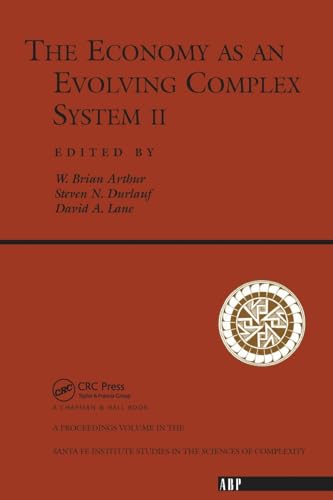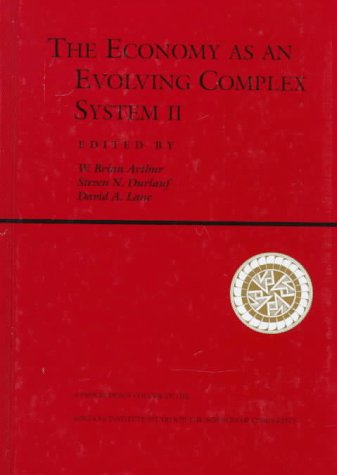W Brian Arthur; Steven N Durlauf; Editor David Lane (4 results)
Product Type
- All Product Types
- Books (4)
- Magazines & Periodicals
- Comics
- Sheet Music
- Art, Prints & Posters
- Photographs
- Maps
-
Manuscripts &
Paper Collectibles
Condition
- All Conditions
- New
- Used
Binding
Collectible Attributes
- First Edition (3)
- Signed
- Dust Jacket
- Seller-Supplied Images
- Not Printed On Demand
Seller Location
Seller Rating
-
The Economy As An Evolving Complex System II (Santa Fe Institute Series)
Published by CRC Press, 1997
ISBN 10: 0201328232ISBN 13: 9780201328233
Seller: MyLibraryMarket, Waynesville, OH, U.S.A.
Book
Paperback. Condition: Very Good. ***Please Read*** very light bump on back top spine- No marks on text - My shelf location 12-C-9*.
-
The Economy as an Evolving Complex System II.
Published by Addison-Wesley, Reading, MA, 1997
ISBN 10: 0201328232ISBN 13: 9780201328233
Seller: Black Cat Hill Books, Oregon City, OR, U.S.A.
Book First Edition
Paperback. Very Near Fine. just a hint of wear to the extremities; else flawless; the binding is square and secure; the text is clean. Free of creases to the panels. Free of creases to the backstrip. Free of creased or dog-eared pages in the text. Free of underlining, hi-lighting, notations, or marginalia. Free of any ownership names, dates, addresses, notations, inscriptions, stamps, plates, or labels. A handsome, nearly-new copy, structurally sound and tightly bound, showing the very mildest wear only. Bright and clean. Corners sharp. Very close to 'As New'. NOT a Remainder, Book-Club, or Ex-Library. 8vo. (9.15 x 6.5 x 1.25 inches). xii, 583 pages. Language: English. Weight: 31.5 ounces. Perseus Advanced Book Program. First Edition Thus (1997), Second Printing. Academic Press Paperback. A new view of the economy as an evolving, complex system has been pioneered at the Santa Fe Institute over the last ten years. This volume is a collection of articles that shape and define this view a view of the economy as emerging from the interactions of individual agents whose behavior constantly evolves, whose strategies and actions are always adapting.The traditional framework in economics portrays economic activity within an equilibrium steady state. The interacting agents in the economy are typically homogenous, solve well-defined problems using perfect rationality, and act within given legal and social structures. The complexity approach, by contrast, sees economic activity as continually changing continually in process. the interacting agents are typically heterogeneous, they must cognitively interpret the problems they face, and together they create the structures markets, legal and social institutions, price patterns, expectations to which they individually react. Such structures may never settle down. Agents may forever adapt and explore and evolve their behavior within structures that continually emerge and change and disappear structures these behaviors co-create. This complexity approach does not replace the equilibrium one it complements it.The papers collected here originated at a recent conference at the Santa Fe Institute, which was called to follow up the well-known 1987 conference organized by Philip Anderson, Kenneth Arrow, and David Pines. They survey the new study of complexity and the economy. They apply this approach to real economic problems and they show the extent to which the initial vision of the 1987 conference has come to fruition.The Economy as an Evolving Complex. First Edition Thus (1997), Second Printing.
-
The Economy as an Evolving Complex System II.
Published by Addison-Wesley, Reading, MA, 1997
ISBN 10: 0201328232ISBN 13: 9780201328233
Seller: Black Cat Hill Books, Oregon City, OR, U.S.A.
Book First Edition
Paperback. Fine. Still in shrinkwrap (so we are not able to confirm that this is a first edition); flawless; the binding is square and secure; the text is clean. 'As New'. NOT a Remainder, Book-Club, or Ex-Library. 8vo. (9.15 x 6.5 x 1.25 inches). xii, 583 pages. Language: English. Weight: 31.5 ounces. Perseus Advanced Book Program. Academic Press Paperback. A new view of the economy as an evolving, complex system has been pioneered at the Santa Fe Institute over the last ten years. This volume is a collection of articles that shape and define this view a view of the economy as emerging from the interactions of individual agents whose behavior constantly evolves, whose strategies and actions are always adapting.The traditional framework in economics portrays economic activity within an equilibrium steady state. The interacting agents in the economy are typically homogenous, solve well-defined problems using perfect rationality, and act within given legal and social structures. The complexity approach, by contrast, sees economic activity as continually changing continually in process. the interacting agents are typically heterogeneous, they must cognitively interpret the problems they face, and together they create the structures markets, legal and social institutions, price patterns, expectations to which they individually react. Such structures may never settle down. Agents may forever adapt and explore and evolve their behavior within structures that continually emerge and change and disappear structures these behaviors co-create. This complexity approach does not replace the equilibrium one it complements it.The papers collected here originated at a recent conference at the Santa Fe Institute, which was called to follow up the well-known 1987 conference organized by Philip Anderson, Kenneth Arrow, and David Pines. They survey the new study of complexity and the economy. They apply this approach to real economic problems and they show the extent to which the initial vision of the 1987 conference has come to fruition.The Economy as an Evolving Complex.
-
The Economy as an Evolving Complex System II.
Published by Addison-Wesley, Reading, MA, 1997
ISBN 10: 0201959887ISBN 13: 9780201959888
Seller: Black Cat Hill Books, Oregon City, OR, U.S.A.
Book First Edition
Hardcover. First Edition (1997), not directly stated; First Printing, so stated and further indicated by a complete numerical sequence. Very Near Fine: shows only the most minute indications of use: just a hint of rubbing to the panels; else flawless; the binding is square and secure; the text is clean. About as close to 'As New'. as you can get and not be simply "As New". NOT a Remainder, Book-Club, or Ex-Library. 8vo. (9.35 x 6.65 x 1.55 inches). xii, 583 pagesr. Language: English. Weight: 35 ounces. Santa Fe Institute Studies in the Sciences of Complexity, Vol 27. First Edition, so stated; First Printing indicated. Hardback: Laminate Boards. A new view of the economy as an evolving, complex system has been pioneered at the Santa Fe Institute over the last ten years. This volume is a collection of articles that shape and define this view a view of the economy as emerging from the interactions of individual agents whose behavior constantly evolves, whose strategies and actions are always adapting.The traditional framework in economics portrays economic activity within an equilibrium steady state. The interacting agents in the economy are typically homogenous, solve well-defined problems using perfect rationality, and act within given legal and social structures. The complexity approach, by contrast, sees economic activity as continually changing continually in process. the interacting agents are typically heterogeneous, they must cognitively interpret the problems they face, and together they create the structures markets, legal and social institutions, price patterns, expectations to which they individually react. Such structures may never settle down. Agents may forever adapt and explore and evolve their behavior within structures that continually emerge and change and disappear structures these behaviors co-create. This complexity approach does not replace the equilibrium one it complements it.The papers collected here originated at a recent conference at the Santa Fe Institute, which was called to follow up the well-known 1987 conference organized by Philip Anderson, Kenneth Arrow, and David Pines. They survey the new study of complexity and the economy. They apply this approach to real economic problems and they show the extent to which the initial vision of the 1987 conference has come to fruition.The Economy as an Evolving Complex. First Edition (1997), not directly stated; First Printing, so stated and further indicated by a complete numerical sequence.



